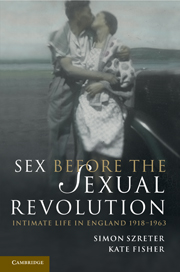Book contents
- Frontmatter
- Contents
- Acknowledgements
- 1 Introduction
- Part I What was sex?
- Part II What was love?
- 4 Romance and love: finding a partner
- 5 Married love: caring and sharing
- Part III Exploring sex and love in marriage
- 10 Conclusion: private lives
- Appendix A The oral history sample: summary of project design and socio-demographic characteristics of the interviewees in Blackburn and north-west Hertfordshire
- Appendix B Note on social classification of the respondents
- Appendix C
- Bibliography
- Index
- Index of interviewees
5 - Married love: caring and sharing
Published online by Cambridge University Press: 05 June 2012
- Frontmatter
- Contents
- Acknowledgements
- 1 Introduction
- Part I What was sex?
- Part II What was love?
- 4 Romance and love: finding a partner
- 5 Married love: caring and sharing
- Part III Exploring sex and love in marriage
- 10 Conclusion: private lives
- Appendix A The oral history sample: summary of project design and socio-demographic characteristics of the interviewees in Blackburn and north-west Hertfordshire
- Appendix B Note on social classification of the respondents
- Appendix C
- Bibliography
- Index
- Index of interviewees
Summary
The most recently published historical interpretations of the history of love, sex and marriage in twentieth-century Britain have reaffirmed the long-standing orthodoxy that the era from 1918 to 1963 witnessed the rise of the companionate marriage as an ideal and a practice. Marcus Collins, for instance, sees this model of mutualist companionship rising to the point of enjoying social ubiquity and dominance in the 1960s and 1970s before subsequently coming under challenge. For Collins ‘[t]he keywords of companionship were intimacy and equality’.
In their recent interpretative textbook, Davidoff et al. agree with Collins that the companionate model became ideologically dominant in mid-twentieth-century Britain. However, they also emphasise tensions between the ideal and practical realities: ‘based upon the idea of an exclusive emotionally and sexually intimate relationship … It was a powerful ideal, which stressed the importance of romantic love, sexual attraction and mutual interests, while disguising realities of gendered inequalities of power and access to resources.’ As Langhamer has argued, the experience of love is ‘rooted in material and cultural as well as emotional, considerations’.
These judicious formulations suggest the need to explore tensions and contradictions and the desirability of a more complex depiction of gender and sexual relations in marriage during the early and mid-twentieth-century decades than one which confines itself to conformity with a linear narrative of the rise of the ideology of companionate marriage.
- Type
- Chapter
- Information
- Sex Before the Sexual RevolutionIntimate Life in England 1918–1963, pp. 196 - 226Publisher: Cambridge University PressPrint publication year: 2010



